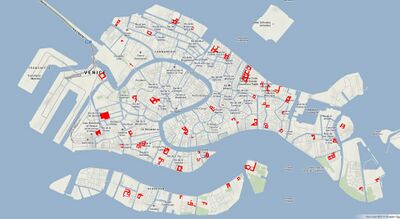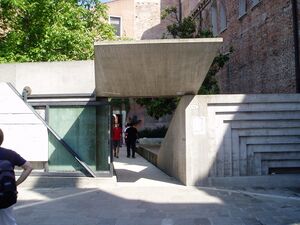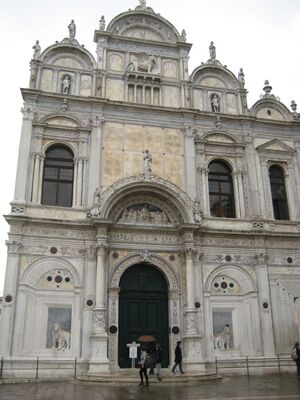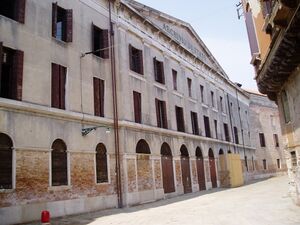Convents: Difference between revisions
Djheinricher (talk | contribs) No edit summary |
Djheinricher (talk | contribs) No edit summary |
||
| Line 47: | Line 47: | ||
==Adaptive Reuse== | ==Adaptive Reuse== | ||
[[File:reuse_chart.jpg|thumb| | [[File:reuse_chart.jpg|thumb|right|The [[Adaptive Reuse of Convents]]]] | ||
[[File:TOLE.JPG|thumb| | [[File:TOLE.JPG|thumb|right|The [[Convent of Saint Nicholas Tolentino]]]] | ||
[[File:GIOV.JPG|thumb| | [[File:GIOV.JPG|thumb|left|The [[Convent of Saint Giovanni e Paolo]]]] | ||
[[File:FRAR.JPG|thumb| | [[File:FRAR.JPG|thumb|left|The [[Convent of the Frari]]]] | ||
Due to the population shift and decline in religious importance within Venice many convents have been renovated and reused for other purposes to accommodate the needs of the city. As the city adapts to host more tourists, most of the convents in Venice have been renovated to be used as buildings such as hotels, museums and government buildings, and schools among many other uses. Only 14% of convents in Venice are actually still used convents, which can be seen in the chart to the | Due to the population shift and decline in religious importance within Venice many convents have been renovated and reused for other purposes to accommodate the needs of the city. As the city adapts to host more tourists, most of the convents in Venice have been renovated to be used as buildings such as hotels, museums and government buildings, and schools among many other uses. Only 14% of convents in Venice are actually still used convents, which can be seen in the chart to the right. The simple layout of convents makes reuse and renovation fairly easy. Convents generally have fairly large and open rooms on the first floor with much smaller and larger quantity of rooms on the upper levels. This arrangement is ideal for modern uses of buildings such as hospitals and prisons. The structural conversion of these rooms is fairly simple, however it is more difficult to update utilities such as electricity and plumbing while still maintaining the historic and cultural integrity of the building. A renovated convent, the [[Convent of Saint Nicholas Tolentino]] can be seen to the leftt. The convent is know part of one of the universities in Venice. | ||
Even the largest convents in the city have been renovated for other purposes. The [[Convent of Saint Giovanni e Paolo]], which once housed the Dominican order, is now used as the main hospital in Venice. Furthermore, the [[Convent of the Frari]] is now used the state archive, replacing the former Franciscan order. Pictures of the both can be seen to the left. | Even the largest convents in the city have been renovated for other purposes. The [[Convent of Saint Giovanni e Paolo]], which once housed the Dominican order, is now used as the main hospital in Venice. Furthermore, the [[Convent of the Frari]] is now used the state archive, replacing the former Franciscan order. Pictures of the both can be seen to the left. | ||
Revision as of 14:29, 6 November 2013
 Convents of Venice | |
| Total Number of Convents | 59 |
|---|---|
| Total Number in Cannaregio | 9 |
| Total Number in Castello | 19 |
| Total Number in Dorsoduro | 13 |
| Total Number in San Marco | 6 |
| Total Number in San Polo | 1 |
| Total Number in Santa Croce | 3 |
| Active Convents | 8 |
This page is an overview of all the convents in Venice. For a typical convent, see Convent.
Convents, or "conventi" in Italian, often accompanied the churches located on the islands of the lagoon. There are 59 convents on located in Venice, excluding the islands of the lagoon. Only eight of these convents still actively house monastic orders. Today, many of these convents have been secularized and reused as less individuals are joining monastic orders. Among the reused convents include both the Convent of the Frari and the Convent of Saint Giovanni e Paolo (both pictured below), which once housed the largest monastic orders in Venice, the Franciscans and Dominicans.
History
As the city of Venice developed and grew, the size of the convents also increased. As staples in the community, affluent families were enthused to send their children to live in monastic orders. A map of the 59 known convents in Venice can be seen to the right. However, civilians began to abuse the religious system, primarily sending daughters to join nunneries to avoid paying a dowry to a prospective husband and his family. Although this provided an influx of nuns, this population did not consist of individuals who would regularly be admitted to the nunneries, which reflected poorly on the churches and monastic orders. In response to this misuse of convents, in 1810, Napoleon demolished several convents in Venice and reused many others as army barracks and prisons. Although drastic, the invasion of convents helped return respect and power to the convents, replacing irresponsible unfit nuns, with devout ones.
Adaptive Reuse




Due to the population shift and decline in religious importance within Venice many convents have been renovated and reused for other purposes to accommodate the needs of the city. As the city adapts to host more tourists, most of the convents in Venice have been renovated to be used as buildings such as hotels, museums and government buildings, and schools among many other uses. Only 14% of convents in Venice are actually still used convents, which can be seen in the chart to the right. The simple layout of convents makes reuse and renovation fairly easy. Convents generally have fairly large and open rooms on the first floor with much smaller and larger quantity of rooms on the upper levels. This arrangement is ideal for modern uses of buildings such as hospitals and prisons. The structural conversion of these rooms is fairly simple, however it is more difficult to update utilities such as electricity and plumbing while still maintaining the historic and cultural integrity of the building. A renovated convent, the Convent of Saint Nicholas Tolentino can be seen to the leftt. The convent is know part of one of the universities in Venice.
Even the largest convents in the city have been renovated for other purposes. The Convent of Saint Giovanni e Paolo, which once housed the Dominican order, is now used as the main hospital in Venice. Furthermore, the Convent of the Frari is now used the state archive, replacing the former Franciscan order. Pictures of the both can be seen to the left.
Map
This map shows the location of all the convents of Venice.
<display_map height=600 zoom=14 centre=45.440155,12.345403> 45.4473,12.32965|Convent of Saint Alvise 45.43242,12.35817|Convent of Saint Anna 45.43462,12.34094|Convent of Saint Apollonia 45.44277,12.33904|Convent of Gesuiti 45.43361,12.34844|Convent of the Ca' di Dio 45.43109,12.32811|Convent of Saint Mary of the Carita 45.43319,12.32181|Convent of Saint Mary of the Carmine 45.4376,12.34987|Convent of the Heavenly 45.44055,12.31681|Convent of Saint Chiara 45.42587,12.3213|Convent of the Converted 45.42538,12.32341|Convent of Saint Cosmo 45.42749,12.36559|Convent of Saint Elena 45.43681,12.33816|Convent of the Fava 45.43734,12.32593|Convent of the Frari 45.43278,12.33286|Convent of Saint Mary of the Giglio 45.44484,12.32032|Convent of Saint Giobbe 45.44027,12.32407|Convent of Saint Giovanni e Paolo 45.44042,12.34233|Convent of Saint Girolamo 45.44582,12.32515|Convent of Saint Giustina 45.43093,112.33397|Convent of Saint Gregory 45.43045,12.35774|Convent of Saint Isepio 45.42454,12.33513|Convent of the Cross 45.43425,12.34601|Convent of Mercy 45.43784,12.34377|Convent of Saint John Lateran 45.44706,12.3949|Convent of Saint Mary of Penitents 45.43684,12.3455|Convent of Saint Lorenzo 45.43543,12.31747|Convent of Saint Mary Maggiore 45.43666,12.34607|Convent of Saint John in Malta 45.42642,12.36267|Convent of the Sisters Mantellate 45.43346,12.33175|Convent of Saint Maurizio 45.44167,12.34275|Convent of the Mendicant 45.42989,12.3339|Convent of the Catechumens 45.43927,12.33938|Convent of Saint Marie of the Miracles 45.43582,12.34884|Convent of the Muneghette 45.43181,12.3233|Convent of All Saints 45.44641,12.33281|Convent of Our Lady of the Garden 45.43292,12.35437|Convent of Saint da Paula 45.43943,12.34537|Convent of the Wailing 45.43426,12.35961|Convent of Saint Pietro 45.42444,12.33267|Convent of the Redentore 45.44367,12.33691|Convent of Saint Caterina 45.43198,12.32418|Convent of the Eremitane 45.43201,12.32425|Convent of the Gesuati 45.43063,12.33538|Seminary di Salute 45.43641,12.33637|Convent of Saint Salvado 45.44187,12.32181|Convent of Saint Maria of the Nazareth of Scalzi 45.43183,12.32025|Convent of Saint Sebastion 45.42898,12.34238|Convent of Saint Giorgio Maggiore 45.4289,12.33046|Convent of the Holy Spirit 45.43381,12.33159|Convent of Saint Stephen 45.43515,12.3403|Convent of Saint Teodoro 45.43336,12.31604|Convent of Saint Teresa 45.43786,12.3228|Convent of Saint Nicholas Tolentino 45.42538,12.33064|Convent of Saint Trinity 45.43861,12.34815|Convent of Saint Francesco de la Vigna 45.42954,12.32687|Convent of Saint Maria della Visitazione 45.42765,12.34088|Convent of 45.43436,12.34369|Convent of Saint Zaccaria 45.42679,12.33922|Convent of Saint Mary of the Presentation </display_map>